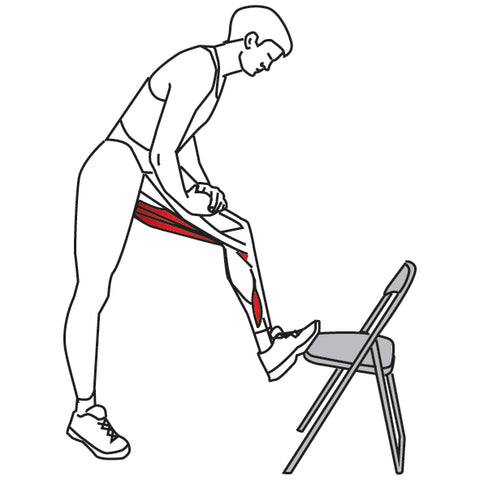Sports Massage for Achilles Tendinopathy
Posted by Stuart Hinds on
Stuart Hinds demonstrates the assessment and treatment of Achilles Tendinopathy
From a dynamic postural viewpoint, the soleus prevents the body falling forward at the ankle joint during standing.
In gait, the muscle eccentrically decelerates subtalar joint pronation and internal rotation of the lower leg at heel-strike. It also decelerates dorsiflexion of the foot. Spasm or myofascial trigger points in the soleus can be the origin of Achilles pain, tight hamstrings, lower back pain, night cramp and even headaches.
The soleus typically refers pain to the posterior aspect and plantar surface of the heel and to the distal end of the Achilles tendon. A rare myofascial trigger point spreads pain to the ipsilateral sacroiliac joint, and can also refer pain to the jaw in extreme cases.
Anatomy
Part of the triceps surae. The soleus is so called because its shape resembles a fish. The calcaneal tendon of the soleus and gastrocnemius is the thickest and strongest tendon in the body.
Origin
Posterior surfaces of head of bula and upper third of body of bula. Soleal line and middle third of medial border of tibia. Tendinous arch between tibia and bula.
Insertion
With tendon of gastrocnemius into posterior surface of calcaneus.

Soleus - Common Trigger Point Sites
Action
Plantar flexes ankle joint. Frequently in contraction during standing, to prevent body falling forward at the ankle joint, that is, to offset line of pull through body’s centre of gravity, thus helping to maintain an upright posture. Antagonist: tibialis anterior.
Nerve
Tibial nerve, L5, S1, 2. BASIC FUNCTIONAL
Movement
Example: standing on tiptoes.

Soleus Trigger Points - Common Referred Pain Patterns
Trigger point referred pain patterns
Pain in distal Achilles tendon and heel to the posterior half of foot. Calf pain from knee to just above Achilles tendon origin. 4–5 cm zone of pain in ipsilateral sacroiliac region (rare).
Indications
Calf/heel/posterior knee pain, chronic/long-term use of high-heeled shoes, plantar fasciitis, chronic calf shortening, calf pain walking stairs, low back pain, leg cramps.
Causes
Post-fracture splinting, poor orthotics, prolonged driving, sports (e.g. running, soccer, cycling, climbing, skiing, rowing machine), footwear (high heels), PSLE, occupational standing, direct blow/trauma, pressure on calf.
Differential Diagnosis
Achilles tendonitis. Compartment syndrome. Vascular disease. Heel spur. Fasciitis. Subtalar joint problems. Venous pump mechanisms. Tendon rupture. Baker’s cyst. Shin splints. Stress fracture. Leg length discrepancy.
Connections
Popliteus, gastrocnemius, tibialis posterior, quadratus plantae (of foot), abductor hallucis (of foot), piriformis, occasionally to jaw.

Soleus Trigger Points can be self-treated but the muscle is deep and pressure tools should not be used without instruction from a professional.

Stretching can be useful and there are many simple stretching exercises for the soleus that anyone can perform at home without special equipment.
Self Help
Self-massage techniques can be helpful; you can even use the opposite knee. Balls and pressure tools may be used but not by the novice, as the muscle is deep and there are many superficial and deep veins in the area.
Stretching is excellent for disabling trigger points in the calf muscles. Use of foam rollers can be effective.
- Change footwear
- Vary running technique/surface
- Avoid high-heeled shoes
- Regular stretching
- Rest the legs at regular intervals
- Use of ice therapy
- Warm up before and cool down after sports activities
- Massage
- Posture
Trigger Point Therapy NAT Foundation Course
Treating Hip Pain & Dysfunction NAT Master Course
About the author
Stuart Hinds is one of Australia’s leading soft tissue therapists, with over 27 years of experience as a practitioner, working with elite sports athletes, supporting Olympic teams, educating and mentoring others as well as running a highly successful clinic in Geelong.
Stuart has a strong following of practitioners across Australia and globally who tap into his expertise as a soft-tissue specialist. He delivers a range of highly sought after seminars across Australia, supported by online videos, webinars and one-on-one mentoring to help support his colleagues to build successful businesses.
In 2016, Stuart was awarded a lifetime membership to Massage & Myotherapy Australia for his significant support and contribution to the industry.
* * *
This trigger point therapy blog is intended to be used for information purposes only and is not intended to be used for medical diagnosis or treatment or to substitute for a medical diagnosis and/or treatment rendered or prescribed by a physician or competent healthcare professional. This information is designed as educational material, but should not be taken as a recommendation for treatment of any particular person or patient. Always consult your physician if you think you need treatment or if you feel unwell.


